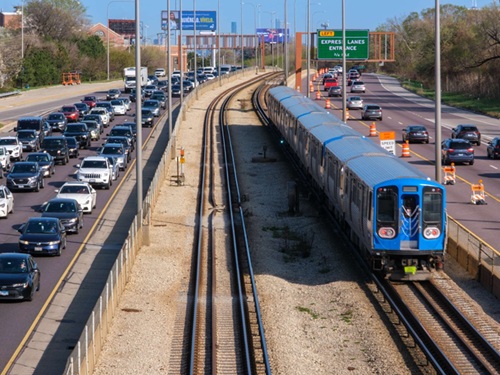The Chicago Transit Board recently approved an agreement with Sensonic Inc. to advance a pilot program that would automatically detect intrusions on Chicago Transit Authority (CTA) railroad right-of-way.
[Above photo by CTA]
CTA said it will test the use of a fiber optic vibration sensing device detect any large objects – such as wildlife, people, or large debris such as trees – falling onto its rail tracks.
“Intrusions onto CTA rail tracks cause service disruptions and can be a deadly, life-changing mistake,” said CTA Acting President Nora Leerhsen in a statement. “With this pilot [project], we are researching a technology that has the potential to create a safer environment for our riders, reduce delays, and improve service reliability.”
The intrusion detection system being tested uses “Distributed Acoustic Sensing” technology that monitors how “light scattering” changes in optical fiber due to acoustic vibrations, such as when a train is crossing a section of track.
CTA said an on-site device will be connected to its existing fiber optic cable for real-time monitoring and will be able to distinguish between normal movement of trains and other types of vibrations on the tracks.
In the case of a person or object entering the tracks, a real-time alert can be triggered based on the vibration pattern, notifying appropriate transit agency staff so they can intervene.
CTA noted that it will work with Sensonic to identify an appropriate location for the pilot test during a “feasibility phase” to gauge the effectiveness of the solution for different types of track – including elevated, grade-level, and in the subway. Sensonic noted that its sensing devices can cover up to a 50-mile range.
CTA noted that this pilot test is scheduled to last 12 months, during which the agency will be able to determine if fiber optic vibration sensing can reliably identify when people or large objects enter the right-of-way and then trigger a real-time alert to enable swift intervention.
With this agreement, CTA will fund the pilot with a $110,700 stipend broken into two phases, with the first milestone covering the evaluation and in-depth feasibility testing and the purchase and installation of testing equipment. This will be paid after CTA receives and accepts report on feasibility.
The second milestone will include the hardware costs for pilot installation at one location as well as a license for a real-time alert monitoring software, the agency said.
 Nation
Nation
The Stream by AASHTO: Electrified Roadway Testing
December 5, 2025 Nation
Nation

